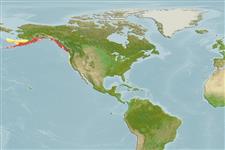Environment: milieu / climate zone / depth range / distribution range
Ecologia
marinhas demersal; intervalo de profundidade 6 - 128 m (Ref. 12204). Temperate; 60°N - 38°N, 175°W - 120°W
Northeast Pacific: southeast Bering Sea to northern California, USA.
Tamanho / Peso / Idade
Maturity: Lm ? range ? - ? cm
Max length : 117 cm TL macho/indeterminado; (Ref. 12204)
Descrição breve
Chaves de identificação | Morfologia | Morfometria
Espinhos dorsais (total) : 72 - 77; Raios dorsais moles (total) : 0; Espinhos anais: 2; Raios anais moles: 43 - 49. Pale brown in color, with touches of yellow or violet (Ref. 12204).
Found on soft bottoms (Ref. 12204). Probably spends part of its life buried (Ref. 12204).
Life cycle and mating behavior
Maturidade | Reprodução | Desova | Ovos | Fecundidade | Larvas
Coad, B.W., 1995. Encyclopedia of Canadian fishes. Canadian Museum of Nature and Canadian Sportfishing Productions Inc. Singapore. (Ref. 12204)
Categoria na Lista Vermelha da IUCN (Ref. 130435: Version 2024-1)
Ameaça para o homem
Harmless
Utilização humana
Ferramentas
Relatórios especiais
Descarregue XML
Fontes da internet
Estimates based on models
Preferred temperature (Ref.
123201): 4.1 - 10.1, mean 6.8 °C (based on 180 cells).
Phylogenetic diversity index (Ref.
82804): PD
50 = 0.6250 [Uniqueness, from 0.5 = low to 2.0 = high].
Bayesian length-weight: a=0.00389 (0.00180 - 0.00842), b=3.12 (2.94 - 3.30), in cm total length, based on all LWR estimates for this body shape (Ref.
93245).
Nível Trófico (Ref.
69278): 3.1 ±0.1 se; based on size and trophs of closest relatives
Fishing Vulnerability (Ref.
59153): High to very high vulnerability (70 of 100).
